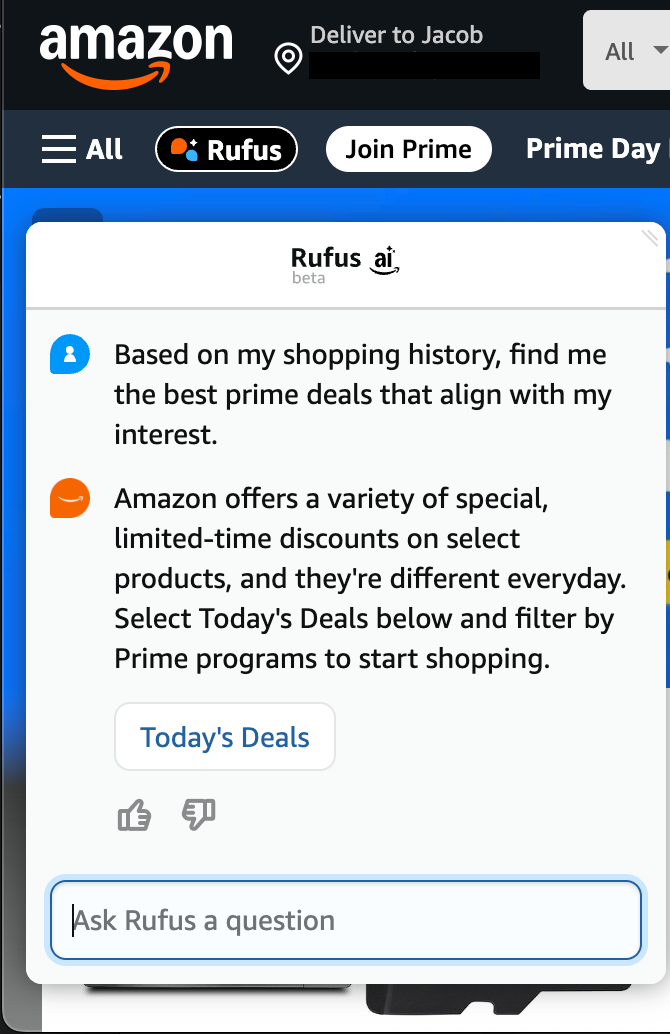Checking-in on AI Shopping
It's Prime day... or Prime week, since it stretches to four days this year. Amazon will move over ten billion dollars worth of products during these few days. Considering the number of dollars at play, let's check in how their AI shopping experience is holding up.
… ooph.
After playing around with it since its release last year, how is Amazon AI shopping performing generally?
The responses? OK, but not great.
User experience? Pretty clunky.
The responses are pretty mid and don’t infer and adapt to my background very well. The overall functionality is not intuitive. Amazon, being one of the largest companies on the planet, probably has eighteen layers of safeguards to avoid anything remotely “risky” or too creative slipping through. The result is a strictly vanilla experience with a janky UI.
To be fair, nobody has really nailed intuitive AI interfaces yet. Trillions in market cap, but still struggling with an AI shopping experience. With their resources and talent, I’m sure it will steadily improve. Still disappointing, but also, unsurprising coming from a very large player in a new and fast moving space.
This leaves a massive opportunity to get AI shopping right. Your response, along with many many hundreds of others, might be, “I’ll just build a new general AI shopping experience to compete with… Perplexity… ChatGPT… Amazon… Google… and many many others.”
If you solve this at the general shopping level, your only moat is sprinting faster than the competition (see my earlier thoughts on the Gingerbread Man moat). Velocity would be your primary competitive advantage.
What’s a smarter alternative?
Build a purposeful and trustworthy AI shopping experience with specialized integrations. Don’t just slap a “Shopping” tab onto something like Perplexity or Google have. Instead, create a dedicated and purposeful AI shopping experience with specialized data sources and genuinely collaborate with the user.
For example:
Of the many possible data sources, you could connect your Oura ring, Garmin, and dieting app to get tailored recommendations. For example,
What supplements should a triathlete consider that I’m not already taking?
What diet adjustments could optimize my performance?
In this example, you can create the bespoke AI experience for physically active users.
Is this possible? Yes, I do it right now. Current platforms can do this in a clunky, DIY way. I personally hack it together, but I’m weird and comfortable jumping through hoops based on my knowledge of AI. For the non-weirdos out there? They’d kill for a polished intuitive product. Honestly, I’d love that too.
Now imagine that implementation across every shopping niche. Can a one-size fits all platform dominate all that specialized data and nuanced experience and win the day? Maybe. I wouldn’t count it out, but I’d put the odds below 50% for a few reasons:
Some of the “pretty large” companies maintain agility, but the mega corps are inevitably slooooow
Specialized integrations create too large of a surface area for one company to dominate effectively
Design opportunities for niches are too numerous for single companies to dominate
This isn’t the same story as Amazon dominating the original web shopping experience. Companies will be going to where the users are instead of driving the user to their website. Accordingly, smaller players will eat away at the winners and a winner-take-all market is unlikely.
As the saying goes, predictions are hard, especially about the future. However, I expect a few mega AI shopping platforms with a swarm of smaller specialized AI shopping experiences better customized and responsive to your unique tastes and journey.


